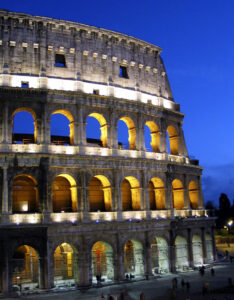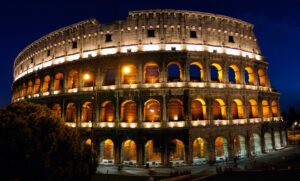Rome was founded in 753 BC and eventually grew to be an ancient city of 2 million people. The Colosseum as we call it but called by the ancient Roman people as The Flavian Amphitheater was built over a period of between 8 and 10 years and completed in 80 AD. It was used continuously for nearly 5 centuries thereafter.
Construction
Built by Vespasian, first of the Flavian Emperors (and who came to power after the last of the Julio-Claudian emperors, Nero, committed suicide). The Colosseum was both a huge public work and a propaganda piece. It was financed by the spoils of the war that resulted in what we call the Diaspora, the destruction of the Temple of Solomon in Israel and the scattering of the Jewish peoples from the Holy Land.
Vespasian built it on land that under Nero had been the site of his private palace. The architectural design was carefully considered. It mirrors the architecture of a building nearby called the Theater of Marcellus, built by Augustus 80 years earlier. So, by demolishing the hated Nero’s lavish palace and grounds and giving the land back to the people by building this grand amphitheater and by designing it to look like a building by Augustus, Vespasian was making two political statements:
1) The old ways and the old dynasty are no more and
2) the new emperor wants to emulate the first and greatest of all the emperors, Augustus, and will return the Roman people to those times.
Photography
It is a favorite place of mine and I have photographed it many times. This photo of the Roman Colosseum at dusk was taken right after sunset in October, 2003.

I used my then-brand new Canon PowerShot G3 and a small tripod set on the banister next to the sidewalk of Via Colosseo, which runs along the front edge of the Oppian Hill, directly across from the Colosseum itself.
This image of the Roman Colosseum at night is a three image panorama done at the same time and location as the one above.

This interior shot of the Roman Colosseum is a multi-image panorama as well.
